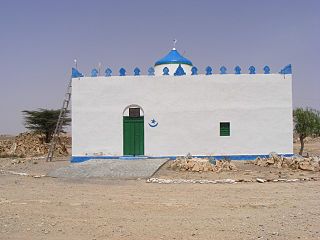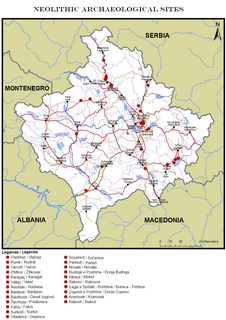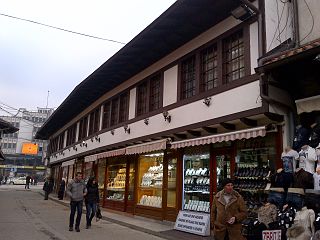Related Research Articles

Lipljan or Lipjan is a town and municipality located in the Pristina District of Kosovo. According to the 2011 census, the town of Lipljan has 6,870 inhabitants, while the municipality has 57,605 inhabitants.

Sukur or Sukur Cultural Landscape is a UNESCO World Heritage Site located on a hill above the village of Sukur in the Adamawa State of Nigeria. It is situated in the Mandara Mountains, close to the border with Cameroon. Its UNESCO inscription is based on the cultural heritage, material culture, and the naturally-terraced fields. Sukur is Africa's first cultural landscape to receive World Heritage List inscription.

Hilary Bradt MBE is the founder of Bradt Travel Guides, a publisher which became an increasingly visible presence in the travel guide book world starting in the mid-1970s.

Pristina is the capital of Kosovo and seat of the eponymous municipality and district. It is the second-largest Albanian-inhabited city in Europe, after Tirana.

Haylan, is a town in the eastern Sanaag region of Somaliland.

Gazivoda Lake, Gazivode Lake, is an artificial lake in Kosovo and Serbia. Gazivoda Lake has an area of 12 km2 (4.6 sq mi) of which 9.2 km2 (3.6 sq mi) reside in North of Kosovo and 2.7 km2 (1.0 sq mi) in Serbia's territory. The lake is formed by the damming of the Ibar River, which flows into the lake.
Ahsikent is a site of ancient settlement and ancient capital of Farghona (Fergana). It is located on the right branch of the Sirdarya River in the Turakurgan district of the Namangan region of Uzbekistan. It is currently under consideration for designation as a UNESCO World Heritage Site.
Tingulli 3nt, also known as Tingulli Trent, is a Kosovo-Albanian hip hop group formed in 1996. The group members are Getoar Selimi and Agon Amiga. His brother "Liberian Selimi" was also active in the rap scene during his teenage years. In the summer of 2010 Tingulli 3nt collaborated with Ermal Fejzullahu, a famous Albanian folk singer. The video of the song was reportedly censured, because of the excessive nudity exposed in the images.
Many places have exonyms, names for places that differs from that used in the official or well-established language within that place, in the Albanian language.

Nor Varagavank is a 13th-century Armenian Apostolic Church monastic ensemble situated 3.5 km southwest of the village Varagavan in the Tavush Province of Armenia. The monastery is situated upon a high hill and is surrounded by forested mountains and picturesque ravines.

Kosovo is situated in south-eastern Europe. With its central position in the Balkans, it serves as a link in the connection between central and south Europe, the Adriatic Sea, and Black Sea. Tourism in Kosovo is characterized by archaeological heritage from Illyrian, Dardanian, Roman, Byzantine, Serbian and Ottoman times, traditional Albanian and Serbian cuisine, architecture, religious heritage, traditions, and natural landscapes.
Baynun fortress was an ancient fortress in Yemen, not far from Sana'a. The geographical dictionary of Yaqut reports that it was a large fortress near San'a' that had been built by Solomon along with Salhin. The ruins of the fortress are on top of a mountain, an ancient site referred to by some as an-Nasla meaning "the dagger of jambiyya". Two sets of ruins of ancient towns exist in the area which were known as ad-Dakhala and Minara. It was a Himyarite stronghold and al-Hamdani reported that King As'ad Tubba' used the fortress as his residence for some time; legend has it that an older Sabaean fortification of Baynun had been constructed for the Queen of Sheba and had been given to her by Solomon. Yaqut claimed it was destroyed during the Abyssinian conquest by the Aksumites in the 6th century, specifically the year 525 in order to overthrow Dhu Nuwas. The poet Dhu Jadan al-Himyari wrote about the destruction of Baynun.

Archaeology of Kosovo as a field of study and research was started in the second half of the 20th century. Kosovo's field of archaeology has developed in tandem with the historical study, studies of ancient authors' sources, classic philological studies, theological data research, topographic studies and ground survey, analysis of toponyms, deciphering of epigraphic and historiographic data. First data about antique monuments in Kosovo, were documented from the end of the 19th until the beginning of the Second World War, a time period when Kosovo was visited by researchers, guides, and archaeologists such as: Evans, Boue, Hahn, Kanitz, Tomaschek, Domaschevski, Arpad, Vulic, Jirecek, Patsch, Domenico Mustilli, etc. In the 1950s, a new era for the ancient studies of Kosovo begins, with prehistoric and antiquity research. Proper development of scientific archaeological research methods starts with the founding of the Museum of Kosovo in 1949, and later these studies are made helped with the establishment of other relevant local and regional institutions. In 2003, Ministry of Culture, Youth and Sports of Kosovo establishes the Archaeological Institute of Kosovo, and since then, continually, besides informative campaigns in field, many archaeological sites were excavated and recorded. Since then geophysical, geomagnetic archaeometallurgical and archaeobotanic studies were performed at some archaeological sites in close cooperation with partners from Germany such as the German Archaeological Institute, and other relevant international institutions with the same inter-disciplinary access. The municipality of Ferizaj specifically has been rich in archaeological findings.

Part of series of articles upon Archaeology of Kosovo

This is a description of Neolithic sites in Kosovo. The warm, humid climate of the Holocene which came soon after the ice melting of the last glacial period brought changes in nature which were reflected in humans, flora and fauna. This climatic stabilization influenced human life and activities; human society is characterized by changes in community organization and the establishment of permanent settlements in dry places, near riverbanks and on fertile plateaus.

Dardania fell under Roman occupation in the first century AD, one of the last territories of Illyria to succumb. Being that Dardania had and today Kosovo has a central position between the road networks that connected the south Aegean with the Danube basin, and with the Adriatic Sea, it was a strategic jewel. It also was important for the Romans due to its rich mineral resources, which they exploited and benefited from. We see that most of the towns of ancient Dardania are located either close to a mine, or close to a road. The Dardanian identity has been disputed for a while, and it is known that it was distinctive, similar to the Illyrian, and also with a Roman or Thracian twist to it, due to the occupation and co-habitation. The archaeological surveys and studies of the last century are helping to establish this Dardanian identity in an objective manner, which will lead to a clearer study and explanation of the continuity of culture in this so much disputed region. Below is a listing of the prominent settlements during the Roman period and an explanation of what they were, when they were inhabited, and when they were founded, accompanied by an array of pictures that illustrate the archaeological finds and remnants.

Historical monuments in Pristina are made up of 21 monuments out of a total of 426 protected monuments all over Kosovo. A large number of these monuments date back to the Byzantine and Ottoman periods. Since 1945, the Yugoslav authorities followed the idea of constructing a modern Pristina by relying in the urban development motto “destroy the old, build the new” and this resulted with major changes in the structure of the buildings, their function and their surrounding environment. However, numerous types of monuments have been preserved, including four mosques, a restored orthodox church, an Ottoman bath, a public fountain, a clock tower, several traditional houses as well as European-influenced architecture buildings such as the Museum of Kosovo. These symbolize the historical and cultural character of Pristina as it was developed throughout centuries in the spirit of conquering empires.

Bazaar of Peja or Peja market is a market place in the center of the city of Peja, in Kosovo. It was established during Ottoman rule and is located near the Pećka Bistrica river, between parallel residence zones. The market historically housed blacksmiths and carpenters but also facilitated the agricultural market. The market place was completely destroyed at least twice, once during the Italian occupation in 1943, and once during the Kosovo War (1998–99). The market was fully rebuilt after the Kosovo War, according to the historical Ottoman architecture, and serves as the main market in the city of Peja, and is one of the many monuments which are under protection by the Republic of Kosovo. The main street of the market is known in Albanian as Çarshia e Gjatë.

The Jashar Pasha Mosque is a Mosque in Prishtina, Kosovo. It was named after Mehmet Yasar.

Prishtina Bus Station is the main bus station in Prishtina, Kosovo, 2 km south-west of the city, near Bill Clinton Boulevard. Prishtina bus station is composed by a bus depot and bus terminals, responsible to provides transport to the rest of Kosovo and continental destinations.
References
- 1 2 Gail Warrander; Verena Knaus (2008). Kosovo: the Bradt travel guide. Bradt Travel Guides. p. 166. ISBN 9781841621999 . Retrieved 2011-07-02.